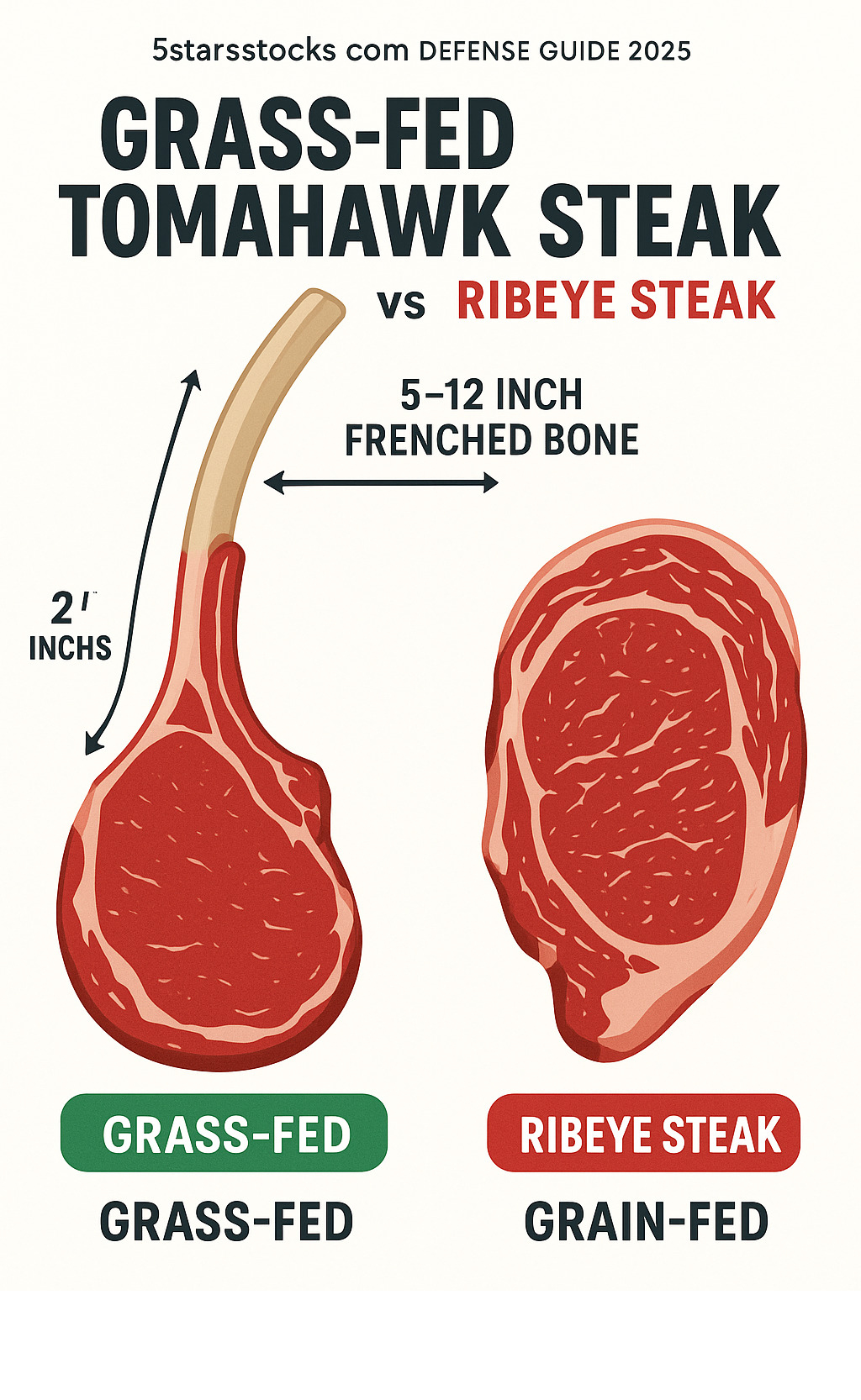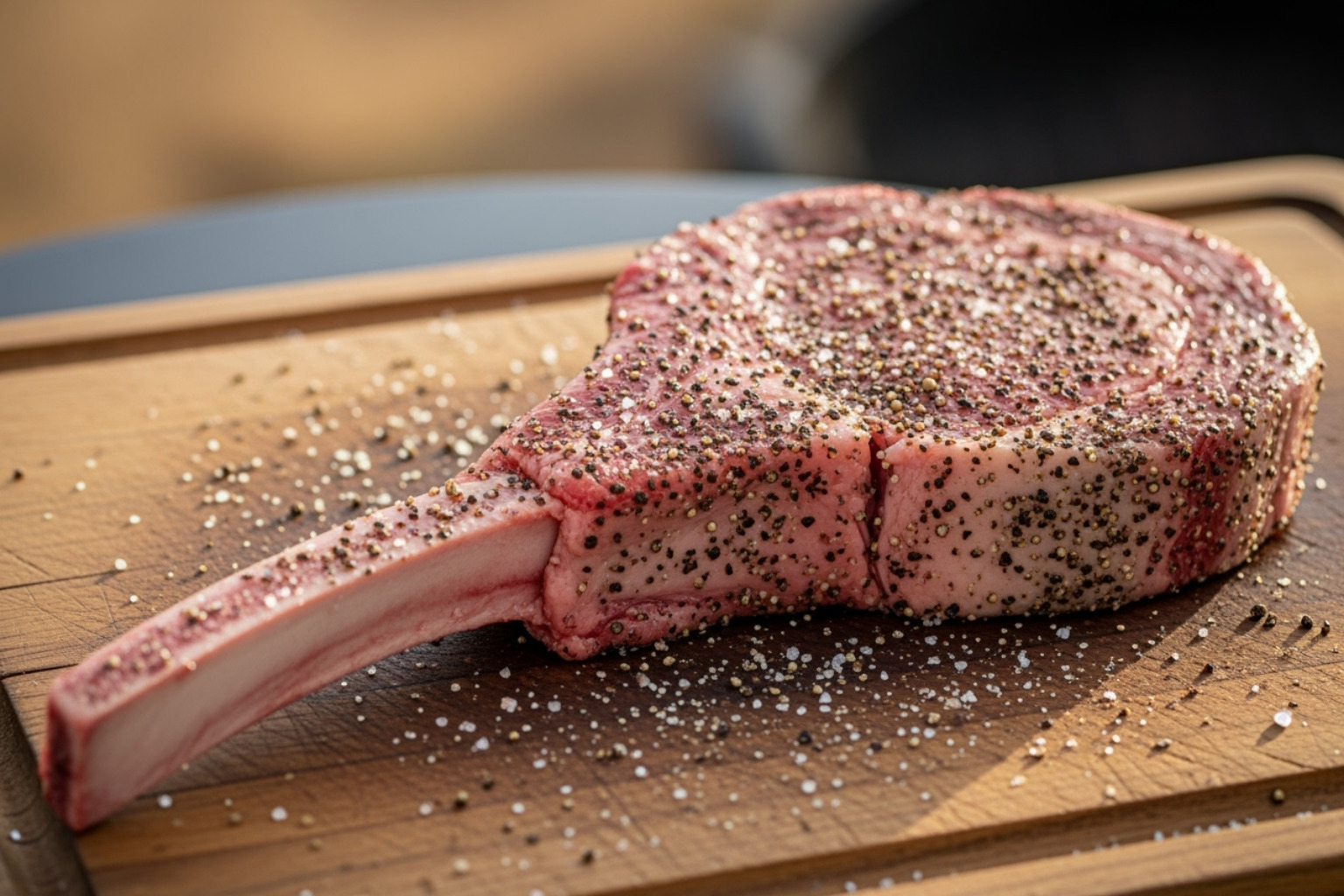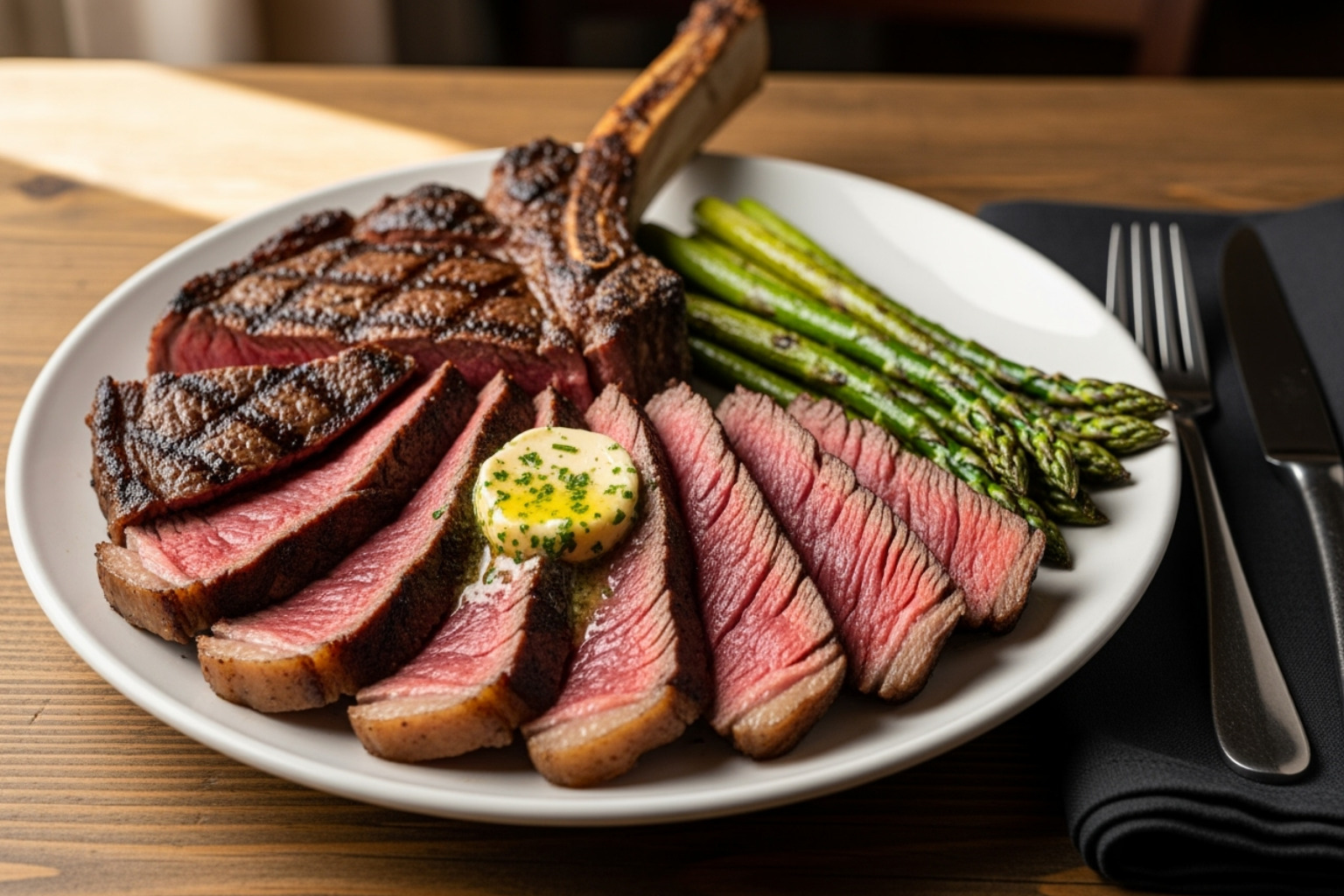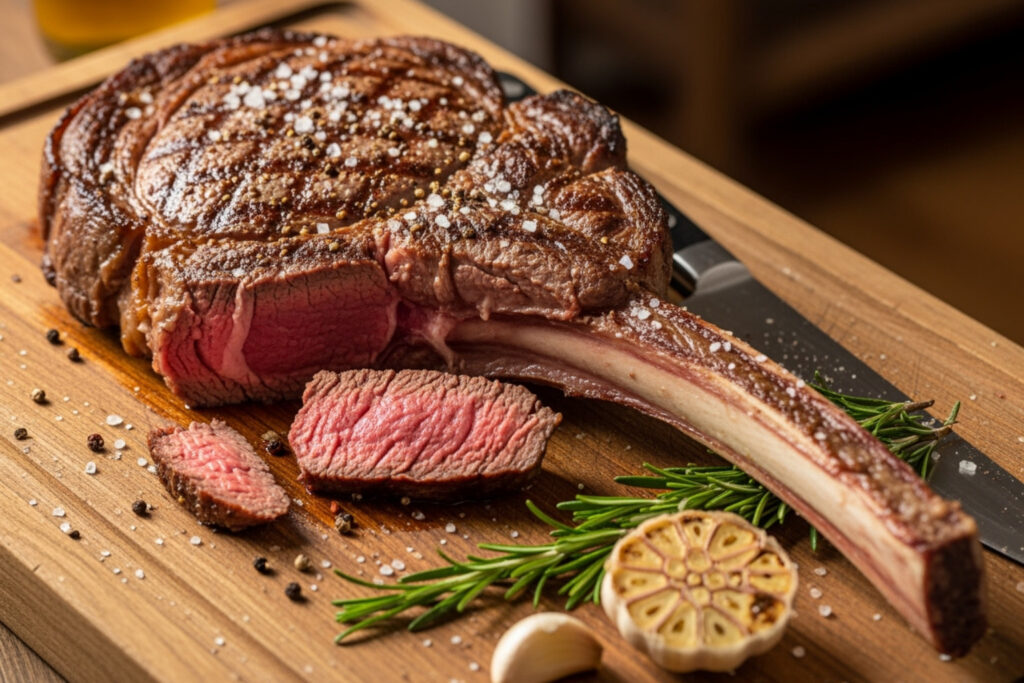What Makes the Grass-Fed Tomahawk Steak the Ultimate Showstopper
A grass fed tomahawk steak is essentially a bone-in ribeye with an extended, frenched rib bone that can stretch 5-12 inches, creating what many call the “Flintstone steak” due to its impressive caveman-like appearance.
Quick Facts About Grass-Fed Tomahawk Steaks:
- Cut: Bone-in ribeye from ribs 6-12 of the cow
- Weight: Typically 2-3 pounds per steak
- Thickness: Around 2 inches thick
- Serves: 2-3 people comfortably
- Price Range: $19-50+ per pound depending on quality
- Key Benefit: Superior flavor profile and nutritional value from grass-fed cattle
This impressive cut has become one of the most popular items at premium steakhouses in Austin and on backyard grills across Portland. The tomahawk gets its name from the long, frenched bone that resembles a tomahawk handle – but it’s far more than just a pretty presentation piece.
What sets the grass-fed version apart is the superior marbling quality and distinct flavor profile that comes from cattle raised on pasture. These animals graze on natural grasses and are often finished with high-quality feed like steam-flaked barley, creating a richer, more complex taste than conventional grain-fed beef.
The bone serves primarily as a dramatic visual element, though it does provide some insulation during cooking. As one expert puts it: “This cut of beef will surely satisfy your caveman or cavewoman instincts” – and when sourced from quality grass-fed operations, it delivers both spectacular presentation and exceptional flavor.

Important grass fed tomahawk steak terms:
The Grass-Fed Advantage: Why It Matters for Your Tomahawk
When you’re investing in a grass fed tomahawk steak, you’re choosing so much more than just an impressive piece of meat. You’re selecting a cut that represents better farming practices, superior nutrition, and a flavor profile that will genuinely surprise you.
Let’s be honest – the difference between grass-fed and grain-fed beef goes far beyond trendy marketing. Conventional grain-fed cattle spend their final months in feedlots, eating corn and soy to pack on weight quickly. While this creates intense marbling, it fundamentally changes what you’re putting on your plate.
Grass fed tomahawk steaks come from cattle that graze on pastures throughout their lives. The best producers often finish their animals with carefully balanced rations of alfalfa, grain hay, and steam-flaked barley for up to 180 days. This finishing process creates optimal marbling while preserving all those grass-fed benefits.
The nutritional advantages are impressive. Grass-fed beef contains significantly higher levels of omega-3 fatty acids – the same healthy fats you get from fish. You’ll also find more antioxidants, particularly Vitamin E, and better overall fat quality. Yes, grass-fed beef tends to be leaner, but don’t worry – a tomahawk’s natural marbling ensures it stays incredibly tender and juicy.
Understanding the Flavor Profile of a Grass-fed Tomahawk Steak
Here’s where things get exciting. A grass fed tomahawk steak doesn’t taste like your typical steakhouse ribeye – it tastes better.
While grain-fed beef often has a one-note buttery richness, grass-fed beef brings complexity to your palate. You’ll notice earthy notes that speak to the animal’s natural diet, combined with a deeper, more robust beefy flavor that’s both rich and clean.
The buttery texture comes naturally from the ribeye’s generous marbling. This intramuscular fat melts during cooking, creating that melt-in-your-mouth tenderness we all crave. The role of marbling becomes even more important with grass-fed beef – it’s what transforms a leaner cut into pure luxury.
Many premium grass fed tomahawk steaks undergo dry-aging for 14-28 days. This controlled aging process breaks down muscle fibers and concentrates flavors, creating an even more intense “beefiness.” The dry-aging impact is remarkable – every bite becomes richer and more complex.
Nutritional Edge and Sourcing
Beyond taste, choosing grass-fed aligns perfectly with making Sustainable Food Choices. These cattle are typically raised without antibiotics or hormones, on farms that prioritize animal welfare and environmental stewardship.
The higher antioxidant content and better fat quality make this an intelligent choice for health-conscious food lovers. You’re not sacrificing flavor for nutrition – you’re getting both in one spectacular package.
Where to buy your grass fed tomahawk steak matters enormously. As a local food expert, I can tell you that local butchers in places like Austin and Boulder are your best resource. They often work directly with Texas Hill Country or Colorado ranches and can tell you exactly where your beef originated. These relationships matter, and supporting Why Locally Sourced Ingredients Make a Difference creates a better food system for everyone.
In areas like Portland, reputable local farms in the Willamette Valley often sell directly to consumers, offering the freshest possible product with complete traceability. High-end grocery stores in all our service areas increasingly stock grass-fed options, though selection varies.
Let’s talk about the typical price range – because yes, this is a premium cut. Expect to pay $19-50+ per pound, with factors like dry-aging and farm reputation affecting cost. A 2.5-3 pound steak might run $90-150, but remember – this feeds 2-3 people comfortably. Compare that to a high-end steakhouse dinner, and suddenly it feels like quite the bargain for an unforgettable home dining experience.
The Ultimate Guide to Cooking a Grass-Fed Tomahawk Steak

I’ll be honest with you – the first time I brought a grass fed tomahawk steak home from my favorite butcher in Austin, I felt a mix of excitement and pure terror. Here’s this magnificent 2.5-pound beast of a steak, and I’m thinking, “How on earth do I not mess this up?” But here’s the beautiful truth: cooking a tomahawk steak is far more forgiving than you’d expect, and the results are absolutely show-stopping, whether you’re grilling on a sunny day in Boulder or in your Portland kitchen.
The secret lies in proper preparation, and trust me, this step makes all the difference. About an hour before you plan to cook, pull that gorgeous steak from the refrigerator and let it bring to room temperature. This isn’t just chef snobbery – it’s science. A steak that starts at room temperature cooks much more evenly than one straight from the cold fridge.
Next, grab some paper towels and pat the steak completely dry. I mean really dry – moisture is the enemy of that beautiful crust we’re after. Once it’s dry, it’s time for seasoning. Keep it simple but be generous. A thick coating of kosher salt and freshly cracked black pepper is all this premium cut needs. The 2-inch thickness can handle plenty of seasoning, so don’t be shy about it.
Best Cooking Methods Explained
After years of experimenting with different techniques, I’ve become a true believer in the reverse sear method for tomahawk steaks. It’s the technique that transformed my steak game completely, and here’s why it works so beautifully.
The reverse sear starts with a low and slow approach. Set your oven to 250°F or prepare your grill for indirect heat at the same temperature. Place your seasoned tomahawk on a wire rack over a baking sheet if using the oven, or on the cooler side of your grill if grilling. This gentle cooking phase can take anywhere from 45 minutes to over an hour, depending on your steak’s exact thickness.
What you’re waiting for is that internal temperature to climb to about 10-15°F below your target doneness. This is where patience pays off in spades. Once you hit that magic number, it’s time for the high-heat finish – and this is where the real excitement happens.
Crank your grill up to 475-500°F or get a cast-iron skillet screaming hot on your stovetop. Now comes the fun part: searing that beautiful steak for 3-5 minutes per side, flipping every 30 seconds until you develop a deep, crusty brown exterior that’ll make your neighbors jealous.
If you’re more of a grilling enthusiast, the dual-zone heat method works wonderfully too. Set up one side of your grill on high heat and keep the other side on low or off completely. Start your tomahawk on the indirect side, then move it over to the blazing hot side for that final sear.
For those cozy nights when you’d rather stay inside, pan-searing followed by oven finishing is your best friend. Heat that cast-iron skillet until it’s smoking, sear for 2-3 minutes per side, then slide the whole pan into a 375-400°F oven to finish cooking.
Here’s a pro tip I learned the hard way: wrap that long bone in aluminum foil during longer cooks. It prevents charring and keeps your presentation picture-perfect.
Temperature, Doneness, and the Importance of Resting
Let me share the most important piece of equipment advice I can give you: invest in a good instant-read meat thermometer. It’s the difference between guessing and knowing, between disappointment and perfection when cooking your grass fed tomahawk steak.
| Doneness | Internal Temperature (Pull from Heat) | Internal Temperature (After Resting) |
|---|---|---|
| Rare | 115-120°F (46-49°C) | 120-125°F (49-52°C) |
| Medium-Rare | 125-130°F (52-54°C) | 130-135°F (54-57°C) |
| Medium | 135-140°F (57-60°C) | 140-145°F (60-63°C) |
| Medium-Well | 145-150°F (63-66°C) | 150-155°F (66-68°C) |
Carryover cooking is real – especially with a thick cut like this. The internal temperature will continue rising even after you pull it from the heat, so always remove your steak a few degrees before your target temperature.
Now comes the hardest part: resting. I know, I know – you want to slice into that beautiful steak immediately. But please, for the love of all that’s delicious, resist that urge! Transfer your perfectly cooked tomahawk to a cutting board, tent it loosely with foil, and let it rest for at least 10-15 minutes. For a steak this substantial, even longer is better.
Why is resting so crucial? During cooking, those muscle fibers contract and push all the precious juices toward the center. Cut too soon, and those juices will run right out onto your cutting board instead of staying where they belong – in your steak. Resting allows everything to relax and those flavorful juices to redistribute throughout the meat, ensuring every single bite is as juicy and tender as possible.
Trust me on this one – the wait is absolutely worth it.
Perfect Pairings and Presentation

The moment of truth has arrived! Your beautifully cooked grass fed tomahawk steak has rested, and now it’s time to transform it into an unforgettable dining experience. This is where technique meets artistry, and trust me, getting it right makes all the difference.
Let’s start with the most important step: slicing against the grain. This isn’t just culinary jargon – it’s the secret to maximizing tenderness in every single bite. Look closely at your steak and you’ll see the direction of the muscle fibers running through the meat. You want to cut perpendicular to these lines, which effectively shortens the fibers and makes each piece incredibly tender. For your tomahawk, you’ll first remove the meat from that impressive bone, then slice the ribeye portion into thick, generous ½-inch slices.
The presentation possibilities are endless, but let’s talk about what truly lifts a grass fed tomahawk steak. Compound butter is pure magic here – imagine softened butter mixed with minced garlic, fresh thyme, rosemary, and oregano slowly melting over those warm slices. The rich, herbaceous butter perfectly complements the robust, earthy flavors that make grass-fed beef so special.
When it comes to sides, roasted vegetables are your best friend. The natural sweetness of roasted asparagus, Brussels sprouts, or a colorful medley of bell peppers and onions from a farmers’ market in Austin or Portland creates a beautiful balance against the richness of the meat. And if you really want to impress, try our Garlic Butter Roasted Mushrooms – they’re absolutely heavenly alongside steak.
Don’t overlook the classics either. Creamed spinach brings that luxurious steakhouse feel right to your dining room, while a perfectly baked potato with all the fixings offers comfort and substance. For those wanting something lighter, a crisp, fresh salad provides a refreshing contrast to the meat’s intensity.
Now for the grand presentation – and this is where the tomahawk truly shines as the ultimate showstopper. Arrange your sliced steak artfully on a large platter, positioning that dramatic frenched bone alongside as a centerpiece. Wrapping the bone in foil during cooking keeps it pristine for this moment. This stunning presentation will have your guests absolutely mesmerized – it’s the kind of visual impact that turns a meal into a memorable experience.
The tomahawk steak truly lives up to its reputation as one of the most impressive cuts available. When you present it properly, you’re not just serving dinner; you’re creating an event that your family and friends will be talking about for years to come.
Frequently Asked Questions about the Grass-Fed Tomahawk Steak
We get a lot of questions about this impressive cut from fellow food enthusiasts here in our communities across Austin, Boulder, and Portland. Let me share the most common ones we hear, along with the insider knowledge we’ve gathered from working with local butchers and testing these magnificent steaks ourselves.
What is the typical size and weight of a tomahawk steak?
When you see a grass fed tomahawk steak for the first time, you’ll understand why people call it the “Flintstone steak” – it’s genuinely massive! These beauties are typically cut about 2 inches thick, which matches the width of the rib bone itself.
In terms of weight, most tomahawks tip the scales between 2 to 3 pounds, though we’ve seen some impressive 3.5-pound specimens that could feed a small army. The cut comes from ribs 6-12 on the cow, which is the same premium section as a regular ribeye – just with that dramatic bone extending out like a handle.
Here’s what makes the size so perfect: one tomahawk feeds 2-3 people comfortably. So while the initial price might seem steep, you’re actually getting great value when you consider you’re feeding multiple people with restaurant-quality beef. It’s become our go-to choice for special dinners and celebrations.
Why are tomahawk steaks so expensive?
I’ll be honest – the first time I saw the price of a grass fed tomahawk steak, I had to do a double-take. But once you understand what goes into this cut, the pricing makes perfect sense.
First, you’re getting a premium ribeye cut, which is already one of the most sought-after pieces of beef due to its incredible marbling and tenderness. Then there’s the butcher skill required – that beautiful “frenched” bone doesn’t clean itself. The process of carefully removing all the meat and fat from the long bone takes time and expertise.
The visual appeal and novelty factor also play a role. When you’re paying for that jaw-dropping presentation and the guaranteed “wow” from your guests, you’re investing in an experience, not just a meal. And let’s not forget the weight of the bone itself – while you can’t eat it, it’s still part of what you’re paying for per pound.
When you choose grass-fed, you’re also supporting sustainable farming practices. Here in our region, that means supporting ranches in the Texas Hill Country or family farms in Oregon that prioritize animal welfare and environmental responsibility. Those ethical practices come with higher production costs, which is reflected in the final price of a grass fed tomahawk steak.
Think of it this way: a tomahawk is often more affordable than taking 2-3 people out to a high-end steakhouse, and the experience of cooking and sharing it at home is pretty special.
Does the long bone actually add flavor?
This is probably the most debated question among steak lovers! I’ve heard passionate arguments on both sides, and honestly, the truth lies somewhere in the middle.
Some experts swear that the bone acts as insulation during cooking, helping the meat near the bone stay more tender and potentially adding subtle flavors as the marrow and connective tissues heat up. There’s definitely some science to support this – bones do conduct heat differently than muscle tissue.
However, other culinary professionals argue that during the relatively short cooking time of a steak, the bone’s flavor contribution is minimal. They see it primarily as the “handle” that gives the tomahawk its distinctive look and aesthetic appeal.
From our experience testing these steaks, we’ve noticed that the meat closest to the bone often has a slightly different texture – usually more tender and juicy. Whether that’s from flavor compounds or just the insulating effect of the bone is hard to say definitively.
But here’s what we know for sure: that long bone creates an undeniable “wow” factor when you present the steak. It’s mostly for presentation, and honestly, that presentation is worth something. When you’re creating a memorable dining experience, the visual impact of a perfectly cooked grass fed tomahawk steak with that dramatic bone is absolutely priceless.
Conclusion
What a journey we’ve taken together exploring the magnificent world of the grass fed tomahawk steak! From understanding what makes this “Flintstone steak” such a showstopper to mastering the art of cooking it to perfection, we’ve covered everything you need to transform your kitchen into a world-class steakhouse.
The grass fed tomahawk steak truly represents the pinnacle of culinary theater – it’s a cut that delivers on both spectacular presentation and exceptional flavor. When you choose grass-fed, you’re not just getting a delicious meal; you’re embracing superior nutritional benefits, supporting sustainable farming practices, and treating your taste buds to those complex, earthy notes that only come from cattle raised the right way.
The key to success lies in the details: bringing your steak to room temperature, seasoning generously with simple salt and pepper, using that foolproof reverse sear method, and – perhaps most importantly – having the patience to let it rest properly. These steps might seem small, but they’re what separate a good steak from an absolutely unforgettable dining experience.
Whether you’re sourcing from a fantastic local butcher in Austin, a specialty shop in Boulder, or directly from a farm near Portland, you’re investing in more than just dinner. You’re creating memories, impressing guests, and celebrating the art of fine dining right in your own home. Pair it with some garlic compound butter, roasted vegetables, or our favorite Garlic Butter Roasted Mushrooms, and you’ve got a meal that rivals any high-end steakhouse.
The grass fed tomahawk steak isn’t just about the meat – it’s about the entire experience. It’s about gathering around the table, sharing something special, and savoring every perfectly cooked bite. We hope this comprehensive guide from The Dining Destination gives you the confidence to tackle this impressive cut and create your own culinary magic.
Ready to explore more premium cuts and cooking techniques? Explore more about the Tomahawk Steak and find your next delicious trip with us.







